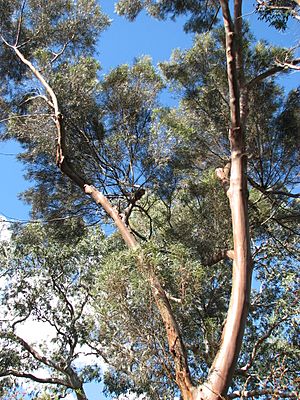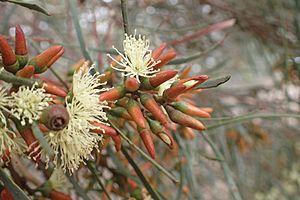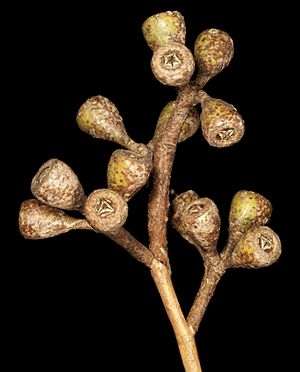Swamp mallet facts for kids
Quick facts for kids Swamp mallet |
|
|---|---|
 |
|
| Scientific classification | |
| Genus: |
Eucalyptus
|
| Species: |
spathulata
|
| Synonyms | |
|
Eucalyptus occidentalis var. spathulata (Hook.) Maiden |
|
The Swamp Mallet (Eucalyptus spathulata) is a special type of tree. It is also known as the narrow-leaved gimlet or swamp gimlet. This tree is found only in Western Australia. It has a thick top part (called a crown) and smooth, shiny bark. Its leaves are long and green. The flowers are white and grow in small groups. After flowering, it produces cup-shaped fruits.
Contents
What Does the Swamp Mallet Look Like?
The Swamp Mallet is a tree that grows many branches close to the ground. It usually reaches a height of 8 to 12 meters (about 26 to 39 feet). Unlike some other eucalypts, it does not have a special woody lump at its base called a lignotuber. The main trunk is often short and can be 1 to 2 meters (about 3 to 6 feet) wide.
Bark and Leaves
The bark of the Swamp Mallet is smooth and feels like satin. It can be greyish-brown or reddish-brown. Young plants have long, thin leaves, about 35 to 50 millimeters (1.4 to 2 inches) long. These leaves are attached directly to the stem or have a very short stalk.
As the tree grows, its adult leaves are also long and thin. They are shiny green on both sides. These leaves are 35 to 95 millimeters (1.4 to 3.7 inches) long and 2 to 6 millimeters (0.08 to 0.24 inches) wide. They narrow down to a small stalk about 1 to 7 millimeters (0.04 to 0.28 inches) long.
Flowers and Fruits
The flowers of the Swamp Mallet grow in groups of three or seven. They are found where the leaves meet the stem. Each group of flowers is on a stalk that is 3 to 15 millimeters (0.12 to 0.59 inches) long. The individual flower buds are oval-shaped. They are 10 to 13 millimeters (0.39 to 0.51 inches) long.
The top part of the bud, called the operculum, looks like a horn or cone. It is two or three times longer than the base of the flower. The Swamp Mallet blooms between December and March. Its flowers are white. After the flowers, the tree produces woody fruits. These fruits are shaped like a cup or cone. They are 3 to 8 millimeters (0.12 to 0.31 inches) long and 4 to 7 millimeters (0.16 to 0.28 inches) wide.
How Was the Swamp Mallet Named?
The Swamp Mallet was officially described in 1844 by a botanist named William Jackson Hooker. He wrote about it in his book Icones Plantarum. The tree was first found near the Swan River by James Drummond.
The name spathulata comes from a Latin word meaning "spoon-like." This refers to something that is broad at the top and gradually narrows down like a stalk. It is not fully known why this specific name was chosen for the tree.
Different Types of Swamp Mallet
Scientists recognize two slightly different types, or subspecies, of the Swamp Mallet:
- E. spathulata subsp. salina: This type has slightly larger fruits. They are 6 to 8 millimeters long and 6 to 6.5 millimeters wide.
- E. spathulata subsp. spathulata: This type has smaller fruits. They are 4 to 7 millimeters long and 4 to 6 millimeters wide.
Where Does the Swamp Mallet Grow?
The Swamp Mallet grows in flat areas, wide valleys, and on small hills. It is often found near salty, low-lying areas and the edges of salt lakes. You can find it in the southern Wheatbelt and inland Great Southern regions of Western Australia. It prefers sandy or sandy-clay soils that are found over granite.
Specific Locations for Subspecies
The subspecies spathulata grows in the areas where the Blackwood River and Pallinup River flow. The subspecies salina is found further north, mainly in the Salt River area.
Plant Communities
Swamp Mallets grow in woodlands. They share their habitat with many other plants, especially different types of melaleuca trees. These include Melaleuca acuminata, Melaleuca pauperiflora, Melaleuca lateriflora, Melaleuca brophyi, and plants from the Melaleuca uncinata group. Other plants found with the Swamp Mallet are Bossiaea halophila, Gahnia ancistrophylla, and Brachyscome lineariloba. These plants are all good at growing in salty, low-lying areas.
Is the Swamp Mallet Protected?
The Western Australian Government's Department of Parks and Wildlife checks on the health of plants.
- The subspecies spathulata is considered "not threatened." This means it is common and not in danger.
- However, the subspecies salina is listed as "Priority Three." This means it is not very well known and found in only a few places. But, it is not in immediate danger of disappearing.
How is the Swamp Mallet Used?
The Swamp Mallet grows at a medium to fast speed and can live for more than 15 years. It is often planted in gardens and farms in southern Australia. It can grow well in salty soil and places where water does not drain easily.
Uses for Wood and Environment
The wood of the Swamp Mallet is strong, hard, and light brown. People use it for firewood and for making crafts. The tree is also planted in gardens because it looks nice and can act as a windbreak. Its flowers produce pollen that is good for bees, which helps with honey production.
The bark of the tree has a lot of tannin, which is used in leather making. The leaves contain cineole, a substance used in some medicines and fragrances. The Swamp Mallet can handle both drought (very dry conditions) and frost (very cold conditions). It can also survive strong, salty winds. This tree has even been grown in California.



